Camino de Santiago - French Way - Stage 14 - Hornillos del Camino to Castrojeriz
Total distance: 20.3 km
Having left Hornillos del Camino and continuing down the valley, after about 5 kilometres you will come to Arroyo San Bol, which someone said “is like an oasis in the middle of the Castilian deserts”. There used to be a hamlet here called San Baudilio and during the 14th and 15th centuries there was a pilgrim's hospital called San Boal run by the Antonin monks. For some unknown reason the hamlet was abandoned in the early 16th century and no trace of it remains.
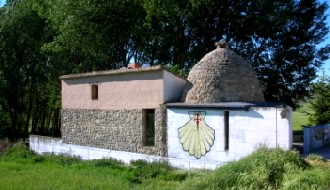
What does remain however is the albergue Arroyo San Bol. It used to be run by hippy volunteers and gained a somewhat disturbing reputation as a party hostel. However, that is a thing of the past as it's under new ownership but it still has a hippy feel, maybe it's the murals that surround it. In the grounds of the albergue is a natural spring where it is said that those pilgrims who wash their feet in it will not have any foot problems from here to Santiago.
Soon after leaving Arroyo San Bol the track descends once more into another valley and then begins to climb and eventually levels out. Other than a couple of now abandoned houses, which you will have recently passed, there is nothing in sight for miles around. If you like birds of prey you may get the occasional glimpse of them flying high on the thermals but the landscape here is mainly wheat fields and little else.
After about 2 kilometres, past a minor road, a valley appears to your right followed by another soon after, suddenly in the distance below you, down a steep descent, is the sight of the church and village of Hontanas.
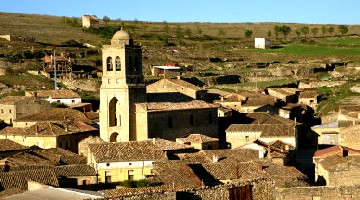
The pilgrim village of Hontanas, which means fountains a name given to the village because of the sheer number of them in the area, is dominated by the 14th century Iglesia de la Inmaculada Concepción.
There are a couple of albergues in Hontanas, one of which is in the recently restored former pilgrim hospital of San Juan as well as a couple of hostals.
If you fancy a swim and you are doing your Camino in the summer there is a municipal swimming pool here.
When you leave Hontanas walk past the swimming pool and down the path. The path runs parallel to the road leading to Castrojeriz, however there is no shade along it. You may wish to walk down the quiet tree lined road which will give you some respite from the sun.
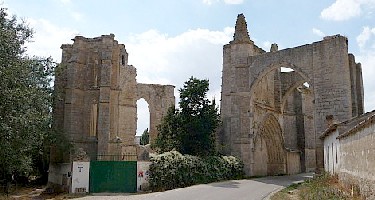
The path will take you past the ruins of the Molino del Cubo, an abandoned mill and through the deserted village of San Miguel before eventually coming across the ruins of the gothic Monasterio de San Antón and the remains of its pilgrims hospital. The Camino continues through the archway across the road.
The hospital was founded by el Orden de los Antonianos (Antonis), a French religious order believed to have healing powers. They specialised in treating a disease known as Saint Anthony's fire, a disease that caused the sensation of burning inside the body if its victims. Other symptoms included gangrene, hallucinations, nausea and vomiting, amongst a raft of other symptoms. The disease originates from a fungus infecting Rye and as we have seen on our journey across the Meseta, cereal crops are the mainstay of the economy in this area. However, in the middle ages rye bread was eaten all across northern Europe but wasn't really known in Spain. Some of the monk's treatments were quite extreme, including amputation but many of the pilgrims that passed this way were “cured” through plenty of exercise, copious amounts of wine and the divine hand of San Anton himself and then sent on their way after being blessed with the ‘Tau' or T shaped cross. The Tau is very closely connected to this area and can be seen in many places around the locality. It is similar to the 19th letter in the Greek alphabet and is considered to be a symbol of protection, therefore the monks wore it and gave it to pilgrims who passed this way as a way to protect them against further sickness and evil.
Within the walls of the monastery is a small albergue. In medieval times those pilgrims who arrived late were left food in little niches in the walls, today many pilgrims write notes and put these into the niches held down by pebbles.
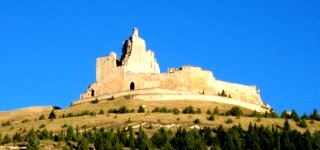
Continuing on the Camino de Santiago, passing through the ruins of San Antón and along the tree lined road you will come, after about 4 kilometres, to Castrojeriz but before you get there you will first spot the ruins of its 9th century Castillo up on the hillside.
You enter the town by turning right passing the Iglesia de Nuestra Señora del Manzano and continue upwards into the centre of Castrojeriz. Like so many of the other towns along the route Castrojeriz is a pueblo calle, basically this means that the village was built around the main street.
There has been a village in this area since celtic times and you can see that it would make an ideal place to settle in, close to a river and ably defended by the hill top fort. The Romans used this vantage point to protect the route to their gold mines in nearby Astorga. But it was in the Middle Ages and the coming of the Camino to Santiago that brought Castrojeriz its prosperity. During the 11th century it became a royal residence and was considered one of the main stopping points along the Camino with its 8 pilgrim hospitals and 9 churches. There were still 7 of these hospitals at the beginning of the 19th century.
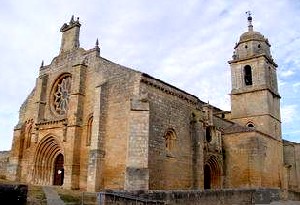
As you entered the village you will have passed by the 13th century church Colegiata de Nuestra Señora del Manzano. Legend says that Santiago is believed to have seen an image of the Virgin Mary in an apple tree. So excited was he that he leapt heavily onto his horse leaving behind hoof prints that can be seen embedded in rock just outside the church.
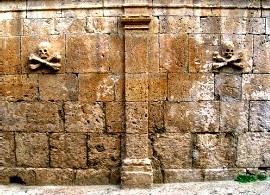
The 16th century Iglesia de Santo Domingo is decorated with slightly gruesome carved skulls but inside you can see some exquisite 17th century tapestries based on Rubens cartoons.
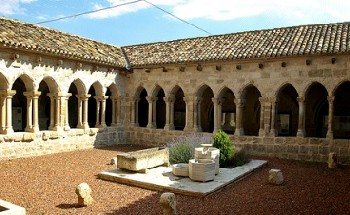
On the other side of the village is the 13th century Iglesia de San Juan de los Caballeros with its beautiful Mudéjar ceilings and impressive cloisters. Parts of the church were built in the 16th century by Rodrigo Gil de Hontañón the architect who was also responsible for the cathedrals in Salamanca and Segovia.
For the best views of the town and the surrounding countryside you should climb up to the ruins of the 9th century castle. Legend claims that this was founded by the Roman emperor Caesar or possibly Pompey, but archaeological investigations have dated it to a much earlier time. Some also say that it was built by the Visigoth King Sigerici circa 760 and that it was from him from whom the town got its name, Castro Sigerici or Castrojeriz. Underneath the castle the hill is honeycombed with tunnels containing bodegas built to keep the wine cool.
If you are staying in Castrojeriz for the night there are 4 albergues, a couple of who have internet access, 3 hostals and a pension, most of whom provide a pilgrim menu, there is also a campsite. There is a shop, bakery and a café, who also has internet access, as well as a bank.

